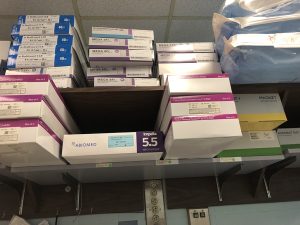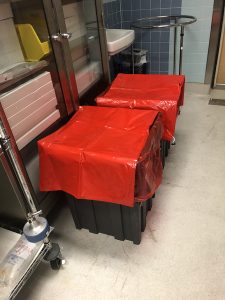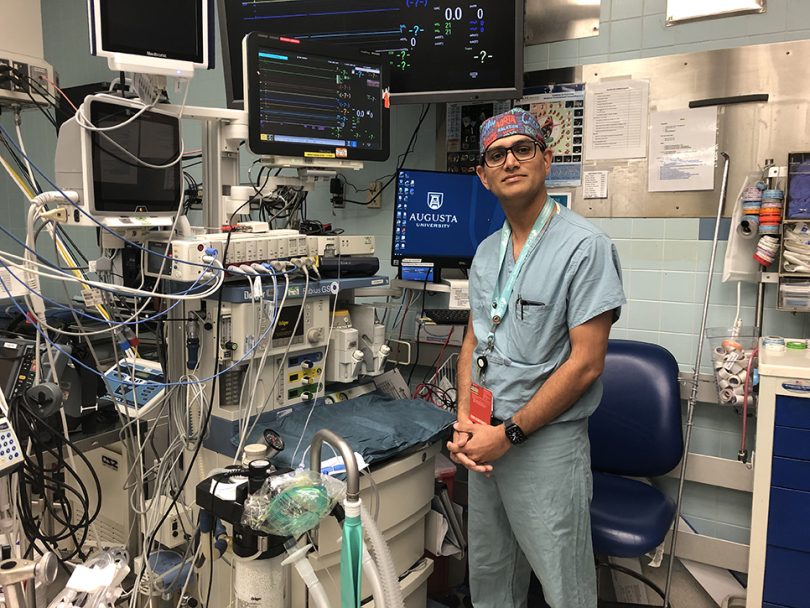A group of anesthesiologists at Augusta University Health want to make the hospital a greener place, and they’re starting with their own department.
They hope to inspire employees across the health system to reduce waste and greenhouse gases.
“When we usually think of greenhouse gas, we always think of cars and factories, right? But U.S. health care can be around 10% of greenhouse gas emissions,” said Dr. Ankit Jain, one of the anesthesiologists who is leading the effort.
He said operating rooms alone generate 20% to 30% of a hospital’s total waste, mostly through disposable, single-use devices and anesthetic gases.
Simple changes such as turning off lights at night in unused operating rooms, using efficient waste disposal, efficient use of HVACs, suction canister systems, reformulating surgical instrument kits and recycling instruments can lead to savings of about $20,000 per operating room, Jain said.
“As anesthesiologists, we have a big role to play. The bulk of that greenhouse gas emission comes from the anesthetic usage and how we use different gases to keep patients comfortable,” Jain said.
The Green Team, made up of health care professionals who are committed to improving environmental sustainability, has outlined a plan called Greening the OR that, if followed by hospital staff, could begin to make a dent in the health system’s waste production and sustainability efforts.
Jain outlined some strategies that can be easily implemented. He said similar sustainability programs in other health systems have realized impressive cost savings.

Much of the waste in an operating room comes from packaging before the patient ever enters the room.
For example, the Cleveland Clinic reportedly saved $4.3 million in 2016 by implementing “a physician-led education and re-training program for red bag waste minimization, a reusable canister fluid management system, a setback program for both its HVAC and its waste anesthetic scavenging systems, and strong medical device reprocessing initiative,” according to Practice Greenhealth. The organization also reported that the Cleveland Clinic saved more than $7.5 million the same year through its “Greening the Operating Room” work.
Strategies proposed
- Reduce unnecessary use of, reuse or reprocess equipment as able
Single-use devices (SUDs) such as pulse oximeter probes, LMAs, blood pressure cuffs, sequential compression devices and certain surgical instruments can be reprocessed to FDA standards by a third-party re-processor.
“We can do some reprocessing of the medical instruments using FDA standards so that we can reuse them in the right way. We can eliminate some of the waste that goes into the way we do sterilization of instruments. For example, we can make kits in a different way, so we are not opening things that we don’t need for a procedure,” Jain said.
Surgical kits repackaged following FDA guidelines are still sterile and safe for patients while reducing unnecessary disposal of unused and unneeded items.
- Decrease inhaled anesthetic waste
Jain said the bulk of a hospital’s greenhouse gas emissions comes from different gases used to keep patients comfortable during surgery.
For example, the use of Desflurane – a general anesthetic used during surgery – for one hour emits the same amount of greenhouse gas as driving a car almost 400 miles. Switching to Sevoflurane creates the same anesthetic effect and comfort for the patient while reducing greenhouse gas emissions to the equivalent of driving a car eight to 18 miles.
“I do want to point out that it’s not about using less anesthetic gases or compromising patient safety in any way. It’s about using them more efficiently,” he said.
- Rationalizing fresh gas flow
High gas flows are needed when the patient is first receiving anesthetic gases and when waking up. In between, while maintaining the patient’s comfort state, the flow can be reduced to lessen the amount of gases that are released into the atmosphere.
- Proper use and disposal of IV anesthetics
Anesthetists can reduce the number of drugs that are prepared for emergencies. Reducing the number of these anesthetics that are drawn up ahead of time can reduce the amount of pharmaceuticals that are wasted.
- Separate, properly dispose of waste, and recycle

Red bags are for disposing of regulated biomedical waste, which is more costly to dispose of than non-regulated waste. Separating waste into appropriate receptacles can help reduce the cost of disposal.
“About 80% of waste is generated before a patient even enters the room,” Jain said.
Much of this waste comes from opening materials and preparation of the space before the operation. This waste can be reduced by recycling plastics, glass, paper and blue wrap before the patient enters the room. Ensuring regulated waste is disposed of separately from regular waste can also have a big impact.
“Regulated medical waste is defined in every state differently, but in general, it is anything that comes in contact with a bodily fluid,” Jain said. “That waste is almost five to 10 times more expensive (to dispose of) than normal waste. When we mix the waste together, everything becomes regulated medical waste. We can segregate 80% of that waste and avoid that additional cost.”
- Donate used functional equipment
Surplus equipment that is in good working condition can be donated to developing countries. In addition to disposing of unneeded equipment, this measure has the added bonus of helping to provide those countries with much needed medical equipment.
- Find other ways to operate sustainably
There are simple things that can be done every day. Do not purchase more supplies than needed. Use low-impact materials such as recycled paper and eco-friendly inks. Substitute digital documents when possible. Use recycled paper.
Starting with themselves
The staff of the Department of Anesthesiology decided to start their greener OR efforts themselves. They’ve already discontinued using Desflurane in favor of the greener Sevoflurane anesthetic gases. They’ve reduced the amount of paper wasted by favoring digital documents during meetings as much as possible. The MCG Anesthesia Green Team even bought each staff member a ceramic mug to be used instead of plastic or Styrofoam disposable cups.
A bulletin board in the department reminds each staff member to do their part. Jain and the rest of the Green Team hope their efforts will inspire others to examine their own uses and find ways to reduce waste within their own departments. With his continued passion and efforts, Jain has successfully created an AU Health sustainability team that is comprised of supply chain, facilities, purchasing, environmental services, nursing staff, cardiac cath lab, and EP representatives. This team is going to look at different ways to reduce cost and make AU Health more sustainable and improve the environment in which we all as a community work and live. His vision is to inspire other departments within AU to look within themselves for ways to reduce waste and find sustainable solutions. He is excited to share his passion with others and wants to make AU Health the leading sustainable health system in Augusta area.
“Hopefully this will lead to change,” he said.


